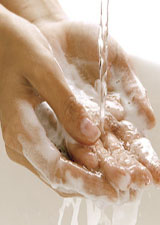
Norovirus is a highly contagious virus that causes severe stomach pain, vomiting and diarrhea.
It is the most common cause of foodborne-disease outbreaks in the US.
The loss of fluids from vomiting and diarrhea can lead to severe dehydration, especially among more vulnerable people.
Every year in the US:
- About 1 out of 15 people contract norovirus
- More than 70,000 people are hospitalized due to norovirus
- Around 600-800 people die from norovirus
How does it spread?
- Norovirus is transmitted when an infected person doesn’t wash their hands properly and comes in contact with others.
- The virus is shed in stool and vomit; so if an infected person doesn’t wash their hands after being ill or using the toilet they can easily spread it to other people.
- Norovirus can live on surfaces for up to two weeks. A person can contract norovirus by touching a contaminated surface (such as a doorknob or light switch) and then touching their mouth, nose or eyes.
How is it treated?
- There is no treatment or vaccine for norovirus, so prevention is key.
- It is important to drink plenty of fluids, including oral rehydration fluids, to prevent dehydration.
- Most people with norovirus get better in 1-3 days
 How to prevent Norovirus infection?
How to prevent Norovirus infection?
- Wash your hands—do not use alcohol based hand sanitizers as they are not effective against norovirus.
- Stay home when you are sick and return to work only when you have been symptom-free for at least 48 hours. Food handlers, childcare workers, and healthcare workers should stay home for 72 hours after symptoms resolve.
- Wash your fruits and vegetables thoroughly.
- Clean and disinfect contaminated surfaces.
- Separate contaminated clothing/linens when washing.
- Wear gloves while cleaning bodily fluids and doing laundry.
Quick cleaning tips:
- Disinfect contaminated surfaces with a bleach solution—use 1/3 cup bleach per gallon of water.
- Do NOT use green cleaners, as they do not kill norovirus.
- NEVER use a wetvac to clean up vomit or bodily fluids—the wetvac spreads contaminants.
- Wear gloves
More information:
Flyers/Posters

